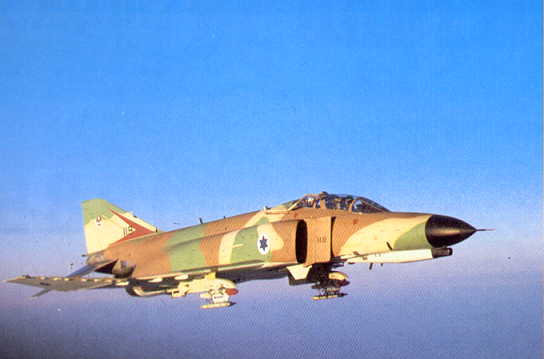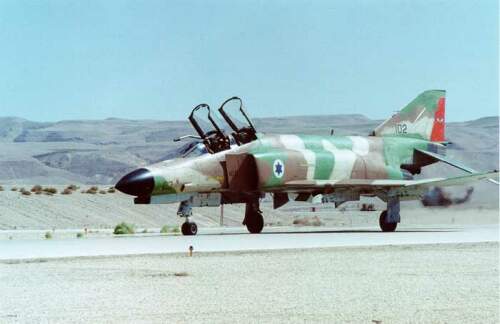McDonnell Douglas F-4 Phantom II (Kurnass)
Previous Page
With the end of the War of Attrition the IAF got back to strengthening its Phantoms fleet, in both numbers and tactics. The IAF had expressed an interest in acquiring more Phantoms long before the end of the war,
and the first 24 ex-USAF examples were delivered during 1971 under operations "Peace Echo II" and "Peace Echo III". 12 more ex-USAF were delievered under "Peace Patch", while 52 more examples were delivered under "Peace Echo IV" beginning in 1972. 24 of these were newly built aircraft. These delieveries enabled the
formation of two new Phantom squadrons, the 107th "Abirey Hazanav Hakatom" (Knights of the Orange Tail) squadron and the 119th "Atalef" (Bat) squadron, which formerly operated the Dassault Mirage IIICJ. At the same time, extensive training took place, in both air-to-air and air-to-surface
scenarios. Air-to-air training which had been rather neglected before was now stepped up, resulting in
a fierce competition with the Mirage squadrons for seniority in the IAF's interceptor role. Air-to-surface training centered on Suppresion of Enemy Air Defence (SEAD) missions,
the difficulties encountered during the War of Attrition urging the IAF to look for better tactics and solutions.
The end of the War of Attrition did not bring about an end to IAF operations and although the Phantom squadrons spent most of their time in training, some combat action was flown as well. During September 1970
combat air patrols were flown over Syrian armour pushing into Jordan, in order to dissuade the Syrian Air Force from intervening. On September 18th 1971, following the downing of an Israeli Stratocruiser by Egyptian SAMs on September 17th, IAF Phatoms and Skyhawks attacked SAM batteries along the Suez Canal, enjoying only limited
success. On September 9th 1972, following the massacre of Israeli atheletes in the Munich Olympics, the F-4s conducted strikes against terrorist positions in Lebanon and Syria. A Syrian SAM battery was destroyed on November 9th, while 2 Syrian MiG-21s were downed on November 21st, after another raid on Syrian targets.
On January 8th 1972 strikes were again conducted against Syrian and Lebanese terrorist camps, and on February 12th an Egyptian MiG-21 was downed attempting to intercept a Phantom reconnaissance flight. Following this last loss, the Egyptian Air Force came under orders not to attempt to intercept Israeli fighters. 1971 also
saw the beginning of Soviet and Arab reconnaissance flights over Israeli territory with the arrival of the MiG-25 Foxbat. IAF attempts to intercept these high flyers failed, although Phantoms were routinely launched against the MiGs and missiles were fired on a number of occasions. The MiG-25 overflights would only cease
with the arrival of the F-15 in 1976. On February 21th 1973 IAF Phantoms shot down a Lybian Air Airlines Boeing 727 after it infiltrated Israeli airspace and attempted to flee when intercepted by the fighters. In a prelude to the Yom-Kippur war, Phantoms and Mirages engaged
Syrian MiGs over northern Syria on September 13th 1973 and managed to down 12 of them for the loss of a single Mirage.

F-4 Phantom II - The Bat Squadron
127 Phantoms were in service with the IAF at the outbreak of the Yom-Kippur War on October 6th 1973. In the 18 days that had become known as the "Phantom's War", the four F-4 squadrons bore the brunt of IAF
operations, flying numerous SEAD, anti-runway, interdiction and strike missions,as well as close air support, interception, reconnaissance and combat air patrol missions.
On the morning of October 6th, IAF F-4s were fully armed to carry out a pre-emptive strike against Egyptian
SAM batteries, but were prevented from doing so by political reasons, as well as by adverse weather conditions. When the war broke out these aircraft were the first to take off and face the aggressors.
The war had begun at 14:00 with a combined assault by Egypt and Syria against Israeli forces in the Sinai Desert and the Golan Heights. The Egyptian advance into the Sinai was accompanied by 200 Egyptian Air Force
aircraft sent to attack IAF installations throughout the peninsula. The first aerial victory of the war came
soon after the beginning of the attack, by a pair of "Orange Tail" Phantoms. The two F-4s had managed to
scramble from Ofir AFB in the midst of an attack by 28 MiG-21s and MiG-17s and shot down 7 of the attackers. "Bat" squadron F-4s which took off from Rephidim shot down an AS-5 Kelt missile and a Sukhoi Su-7. Other
aircraft which had taken off in the beginning of the war also attacked Syrian and Egyptian armour, losing one aircraft to an Egyptian SAM. The second major Egyptian Air Force action on the first day came at dusk with a
commando assault involving dozens of Mi-8 helicopters. Seven helicopter were downed by Phantoms fron the 201st "The One" squadron, including one deliberately driven into the ground by the jetwash from a Phantom's
afterburners.
From the beginning of hostilities the IAF achieved total aerial superiority, with 277 Arab fighters downed for the loss of only a handful of Israeli fighters shot down by Arab fighters. 117 engagements had taken
place during the war, the IAF achieving a kill ratio four times highter than the ratio achieved during the Six Days War. The fight against enemy air defences, especially the SAM batteries, proved to be a different
matter altogether. The IAF entered the war without a practical solution to the Arab SAM threat. Tactics had not changed much since the War of Attrition and the IAF lacked the proper electronic equipment and munitions
to counter the missiles. The problem was further exasperated by the latest addition to the Egyptian and Syrian air defence forces, the new SA-6 Gainful. The technniques used against the stationary radar guided SA-2s and SA-3s were useless against these mobile infrared guided missiles and these were to exact a heavy toll
from the IAF. Other new threats were the new shoulder-mounted SA-7 Grail and ZSU-23 AAA. Egypt entered the war with 106 SAM batteries, while Syria had a further 23.
On the morning of Sunday, October 7th, a massive attack was about to be launched against Egyptian air bases but it was called off in view of the desperate situation on the Golan Heights. Under operation "Doogman 5B"
(model 5B) the IAF launched dozens of its F-4s and A-4s against the Syrian SAM array on the Heights. Having gone in with insufficient intelligence against a deadly opponent, six Phantoms were lost during that single
day. With only a single SAM battery destroyed, October 7th was a resounding defeat and the IAF avoided confronting the Syrian SAMs again. By the end of the war the IAF had destroyed only 3 Syrian batteries, leaving most of the work to IDF ground forces.
The Egyptian air defence array was the most extensive the world had ever seen. Unlike the Syrians, the Egyptians had not advanced their SAM batteries into the Sinai along with their ground forces, providing
dense coverage from across the Suez Canal. On October 8th the IAF managed to destroy a number of Egyptian batteries in the northern Canal region. SEAD attacks were stepped up on October 11th, by which the Syrian
advance on the Golan Heights had been pushed back. The turning point in the war on the southern front came on October 14th with the failure of an Egyptian armoured offensive and a subsequent Israeli drive across the
Suez Canal into mainland Egypt. Abandoning the former tactic of attacking the heart of the Egyptian air defences, the IAF begun attacking the flanks of the air defence array, especially the norhtern flank, while
IDF ground forces begun destroying SAM sites on the southern flank. As the war went on the IAF managed to disable large portions of the Egyptian air defence, allowing it more freedom of action as well as punching
holes in the Egyptian defences through which it could penetrate deep into Egypt. 32 Egyptian batteries were destroyed by the end of the war on October 24th. This was however achieved with the loss of a great number of aircraft and in order
to make good these losses, 36 USAF Phantom were transferred to Israel under "Nickel Grass", along with A-4 Skyhawks, Shrike and Maverik missiles, Chapparel SAMs and more.

F-4 Phantom II - Knights of the Orange Tail Squadron
Besides their fight against enemy air defences, the Phantoms also conducted numerous long range strikes against strategic sites deep inside Egypt and Syria. On October 9th, in retaliation to surface-to-surface missile attacks against Israeli civilian targets, the IAF launched strikes against Syrian strategic targets, first and foremost the Syrian HQ in the heart of Damascus. Other targets included Syrian power stations, fuel depots, refineries, bridges and more. On one such attack on October 23rd, 10 Phantoms and 4 Neshers engaged 20 Syrian MiG-21s and shot down 9 of them, 4 falling prey to the Phantoms. IAF Phantoms also routinely visited Arab air bases in a bid to disable the Egyptian and Syrian air forces and to disrupt the Soviet airlift assisting the Arab offensive.
Hulhul, Saykal and Haleb AFBs in Syria were attacked on October 8th, 11th and 12th, for instance. On October 12th the "One" squadron attaked Damascus International airport while the "Bat" squadron attacked a Syrian Air Force bunker. Large scale attacks took place on October 14th and 15th to prevent the Egyptian air force from supporting the Egyptian ground offensive. Mansura, Tanata and Tsalchiya were amongst the Egyptian air bases routinely targeted.
The Phantoms were the backbone of the IAF during the Yom-Kippur War, as many as six sorties per plane flown every day while carrying out virtually any mission assigned to them. Nearly 100% of IAF stategic strikes were conducted by the F-4s, with such success that Syria continued to suffer power shortages long after the end of the war. Responsible for 30% of all IAF aerial kills, 27 Phantoms were lost by the war's end, the majority of them to enemy air defences. Different Phantom squadrons fared differently, the "Orange Tail" squadron suffering no fatalities, while the "One" squadron lost a number of pilots but was the top scoring F-4 squadron of the war.
Despite the hardships encountered during October 1973, the IAF's Phantom fleet emerged strengthened from the Yom-Kippur War. Battle-hardened and combat-proven, the experience gained in the fight against the Arab air defence forces proved invaluable in the next Arab-Israeli war, operation "Peace for Galilee".
Next Page
back to Inventory page
my email : skythe@iname.com
 back to the IDF/AF page
back to the IDF/AF page



 back to the IDF/AF page
back to the IDF/AF page